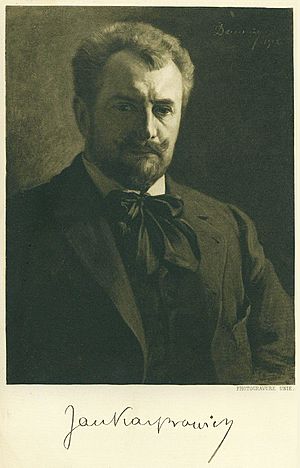Terza rima facts for kids
Terza rima is a three-line rhyme scheme of Italian origin.. The first line rhymes with the third one. The second line is free and can rhyme with a line in the next strophe.
Terza rima occurs in sonnets. Sonnets are often composed of two quatrains and two terza rimas, for example abba abba cdc dcd. This scheme can be found in many Italian, Spanish and Portuguese sonnets. This sonnet by the 16th century Portuguese poet Francisco de Sá de Miranda is a good example.
O sol é grande, caem co’a calma as aves,
do tempo em tal sazão, que sói ser fria;
esta água que d’alto cai acordar-m’-ia
do sono não, mas de cuidados graves.
Ó cousas, todas vãs, todas mudaves,
qual é tal coração qu’em vós confia?
Passam os tempos vai dia trás dia,
incertos muito mais que ao vento as naves.
Eu vira já aqui sombras, vira flores,
vi tantas águas, vi tanta verdura,
as aves todas cantavam d’amores.
Tudo é seco e mudo; e, de mestura,
também mudando-m’eu fiz doutras cores:
e tudo o mais renova, isto é sem cura!
Usually terza rimas are linked to each other making long chain-like sequences. There is an extra line at the end of the sequence. The scheme of rhymes is: aba bcb cdc ded... xyx yzy z. Terza rimas are suitable for long poems. The best known example is The Divine Comedy by Dante Alighieri. Perhaps every child in Italy knows these lines by heart.
Nel mezzo del cammin di nostra vita
mi ritrovai per una selva oscura,
ché la diritta via era smarrita.
Ahi quanto a dir qual era è cosa dura
esta selva selvaggia e aspra e forte
che nel pensier rinova la paura!
Tant’è amara che poco è più morte;
ma per trattar del ben ch’i’ vi trovai,
dirò de l’altre cose ch’i’ v’ ho scorte.
Spanish poet Bernardo de Balbuena, who lived in Mexico, wrote a long poem in terza rima named Grandeza mexicana
Oh tú, heroica beldad, saber profundo,
que por milagro puesta a los mortales
en todo fuiste la última del mundo;
criada en los desiertos arenales,
sobre que el mar del sur resaca y quiebra
nácar lustroso y perlas orientales;
do haciendo a tu valor notoria quiebra,
el tiempo fue tragando con su llama
tu rico estambre y su preciosa hebra;
In Britain Robert Browning used terza rima in The Statue and the Bust:
There ’s a palace in Florence, the world knows well,
And a statue watches it from the square,
And this story of both do the townsmen tell.
Ages ago, a lady there,
At the furthest window facing the east,
Asked, “Who rides by with the royal air?”'
The bridesmaids’ prattle around her ceased:
She leaned forth, one on either hand;
They saw how the blush of the bride increased.
Percy Bysshe Shelley invented a sonnet built of fout terza rimas and a couplet. It rhymes aba bcb cdc ded ee. Shelley used it in Ode to the Western Wind. It consists of five sonnets. Let us look at the first one.
O wild West Wind, thou breath of Autumn's being,
Thou, from whose unseen presence the leaves dead
Are driven, like ghosts from an enchanter fleeing,
Yellow, and black, and pale, and hectic red,
Pestilence-stricken multitudes: O thou,
Who chariotest to their dark wintry bed
The winged seeds, where they lie cold and low,
Each like a corpse within its grave, until
Thine azure sister of the Spring shall blow
Her clarion o'er the dreaming earth, and fill
(Driving sweet buds like flocks to feed in air)
With living hues and odours plain and hill:
Wild Spirit, which art moving everywhere;
Destroyer and preserver; hear, oh hear!
American poet Robert Frost in his poem Acquainted with the Night used aba bcb cdc dad aa scheme.
Jan Kasprowicz, who translated Shelley's poem into Polish, used this scheme in a work by his own. It is called Cisza wieczorna. (Evening Silence).
Another form composed of terza rimas is a villanelle. It is made up of nineteen lines. It rhmymes acording to the scheme aba aba aba aba aba abaa. An example is Do not go gentle into that good night by Welsh poet Dylan Thomas.
See also
 In Spanish: Terceto encadenado para niños
In Spanish: Terceto encadenado para niños






